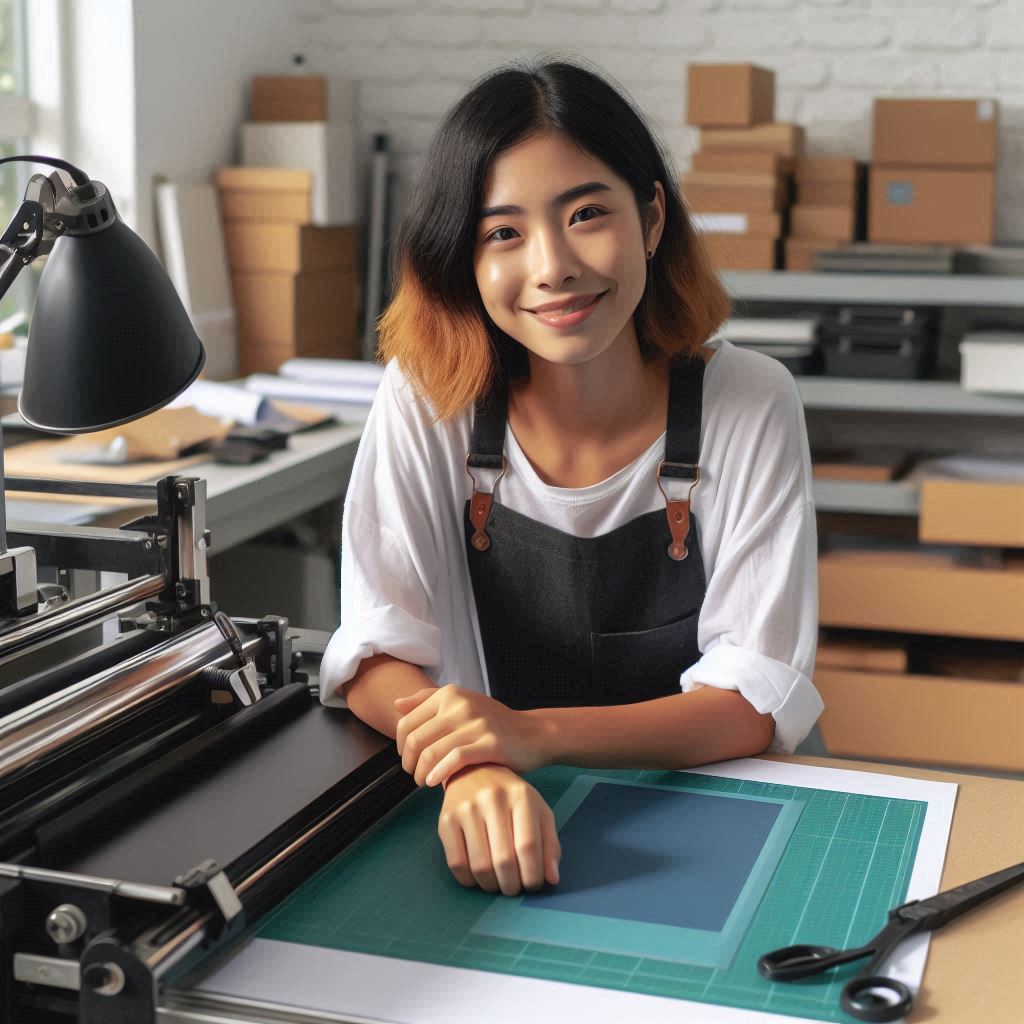Introduction
Sustainable practices in printmaking focus on reducing environmental impact while maintaining artistic quality.
Traditional printmaking often involves processes that harm the environment.
Adopting sustainable methods helps mitigate these effects and promotes eco-friendly artistry.
Sustainable practices aim to minimize waste and pollution.
They emphasize using non-toxic materials, recycling, and conserving resources.
By implementing these methods, printmakers can reduce their carbon footprint and protect natural ecosystems.
Traditional printmaking practices often involve harmful chemicals and large amounts of waste.
Solvents, acids, and heavy metals can contaminate water sources and soil.
Additionally, excessive paper waste contributes to deforestation and environmental degradation.
Embracing sustainable practices in printmaking offers numerous benefits.
It ensures that artists can continue creating while preserving the planet.
Eco-friendly methods support long-term environmental health and foster a more responsible art community.
Overall, integrating sustainability into printmaking is not just an option but a necessity.
It aligns artistic practices with environmental stewardship, ensuring that art does not come at the cost of nature’s well-being.
Use of Non-Toxic Materials
The importance of using non-toxic inks and materials in printmaking
Printmaking is a powerful medium, but traditional methods often use materials harmful to health and the environment.
Embracing non-toxic materials is crucial for a safer and more sustainable practice.
Using non-toxic inks and materials is important for several reasons.
Traditional printmaking inks contain harmful solvents and chemicals that can be harmful to artists’ health.
Prolonged exposure can lead to respiratory issues, skin irritation, and other health problems.
Non-toxic alternatives significantly reduce these risks, creating a safer workspace.
Transform Your Career Today
Unlock a personalized career strategy that drives real results. Get tailored advice and a roadmap designed just for you.
Start NowExamples of sustainable and non-toxic alternatives to traditional printmaking materials
Examples of sustainable and non-toxic alternatives to traditional printmaking materials abound.
Water-based inks are a popular choice, as they eliminate harmful solvents and reduce environmental impact.
Soy-based inks are another excellent option; they are derived from renewable resources and are biodegradable.
For cleaning purposes, vegetable-based solvents are available, which are less harmful than traditional chemical solvents.
Eco-friendly papers, often made from recycled materials, also contribute to a sustainable practice.
How non-toxic materials are better for both artists and the environment
Non-toxic materials benefit both artists and the environment.
For artists, using non-toxic materials means fewer health risks and a safer studio environment.
Artists can work without worrying about the long-term effects of harmful chemicals.
For the environment, non-toxic inks and materials reduce pollution.
They often require less energy to produce and are easier to dispose of safely.
Incorporating non-toxic materials into printmaking practices is a step towards sustainability.
It not only protects the health of artists but also contributes to a healthier planet.
By choosing safer materials, printmakers can continue their craft responsibly and with greater peace of mind.
Read: Famous Ceramic Artists You Should Know
Recycled Paper and Supplies
The benefits of using recycled paper and supplies in printmaking
Incorporating recycled paper and supplies into printmaking offers numerous benefits.
Recycled paper significantly reduces the demand for virgin pulp, conserving trees and natural resources.
It lowers the energy and water usage required for paper production, leading to a smaller environmental footprint.
How using recycled materials can reduce waste and carbon footprint
Using recycled materials also plays a crucial role in waste reduction.
Traditional paper production creates substantial waste, but recycled paper helps to mitigate this problem by repurposing used paper products.
Showcase Your Business Today
Reach thousands of readers actively exploring professional services. Publish your business profile and grow your audience now.
Publish NowThis practice decreases the volume of waste that ends up in landfills and reduces the overall carbon footprint associated with paper manufacturing.
To further minimize environmental impact, artists should consider several tips for sourcing sustainable materials.
Begin by researching suppliers who specialize in eco-friendly or recycled products.
Look for certifications such as the Forest Stewardship Council (FSC) or the Recycled Paper Coalition to ensure the materials meet sustainability standards.
Tips on sourcing sustainable and recycled paper and supplies for printmaking projects
Additionally, seek out local suppliers to reduce transportation emissions and support regional economies.
Engage with printmaking communities or networks that share information on sustainable practices and resources.
Many artists also find success in repurposing old prints or paper scraps, turning potential waste into valuable materials for new projects.
By choosing recycled paper and supplies, printmakers not only contribute to environmental conservation but also set a positive example for the art community.
Embracing these practices helps to ensure that printmaking remains a sustainable and eco-conscious craft for future generations.
Read: Incorporating Printmaking into Mixed Media Art
Energy-Efficient Equipment
The significance of using energy-efficient equipment in printmaking studios
Using energy-efficient equipment is crucial for sustainable printmaking practices.
It significantly reduces the studio’s energy consumption, benefiting both the environment and operational costs.
Energy-efficient tools not only cut down on electricity use but also support a more eco-friendly approach to art production.
The impact of energy consumption on the environment and ways to reduce it
Energy consumption has a direct impact on the environment.
Traditional printmaking equipment often uses excessive energy, contributing to increased greenhouse gas emissions.
By switching to energy-efficient equipment, artists can minimize their carbon footprint and reduce environmental damage.
Lower energy consumption leads to less strain on power grids and decreases the reliance on non-renewable energy sources.
To lower energy consumption, consider adopting several strategies.
First, upgrade to energy-efficient printers and presses that consume less electricity.
Look for devices with Energy Star ratings or similar certifications.
These models are designed to use power more efficiently and have a reduced environmental impact.
Additionally, use LED lighting in your studio. LEDs are more energy-efficient than traditional bulbs and have a longer lifespan, reducing the need for frequent replacements.
Recommend energy-efficient tools and machinery for a sustainable printmaking practice
Several energy-efficient tools and machines are available for sustainable printmaking.
Consider investing in a high-efficiency press, which uses less power and requires fewer resources.
Also, explore options for eco-friendly inks and solvents that align with energy-efficient practices.
Another effective solution is to use digital tools that allow for precise control of energy use during the printing process.
By adopting these practices, printmakers can contribute to a more sustainable future.
Energy-efficient equipment not only benefits the environment but also enhances the overall efficiency of the printmaking studio.
Embracing these changes helps ensure that art production aligns with sustainable values and minimizes its ecological footprint.
Read: Ceramic Art: Techniques and Tools Explained

Water Conservation Techniques
The importance of water conservation in printmaking processes
Water conservation is crucial in printmaking due to environmental impacts and resource efficiency.
Printmaking processes often use large amounts of water, which can strain local resources and contribute to pollution.
By adopting water conservation techniques, artists can significantly reduce their environmental footprint.
Strategies for reducing water usage in printmaking without compromising the quality of the prints
To start, it is essential to understand why conserving water matters.
Printmaking involves various stages, including washing screens and cleaning equipment, which traditionally consumes considerable water.
Reducing water usage helps preserve local water supplies and decreases the load on wastewater treatment facilities.
This practice aligns with broader environmental sustainability goals.
Tips for artists on how to recycle and reuse water in their printmaking practice
Artists can adopt several strategies to minimize water use while maintaining print quality.
Firstly, use water-efficient tools and equipment designed to reduce waste.
For instance, opt for brushes and sponges that require less water for cleaning.
Showcase Your Business Today
Reach thousands of readers actively exploring professional services. Publish your business profile and grow your audience now.
Publish NowSecondly, control the amount of water in inks and cleaning solutions.
Use only the necessary amount for the task at hand to avoid excess.
Additionally, implement a cleaning protocol that uses minimal water, such as pre-rinsing with a small amount before washing with more.
Recycling and reusing water are effective methods for further conservation.
Collect rinse water in containers and reuse it for initial washes or pre-rinsing tasks.
This reduces the need for fresh water and minimizes wastewater.
Install a filtration system to clean and purify used water, making it suitable for reuse.
Lastly, adopt a closed-loop system where water is continually reused and recycled within the studio.
This approach minimizes waste and optimizes water usage.
By incorporating these water conservation techniques, printmakers can make a positive impact on the environment.
Adopting these practices not only supports sustainability but also enhances the overall efficiency of the printmaking process.
Read: Top Ceramic Art Schools in the USA
Waste Reduction and Recycling
Printmaking, like any other artistic practice, generates waste that can have a significant impact on the environment.
It is essential for printmakers to be mindful of waste generation and take steps to minimize it.
Here are some ways to address the issue of waste in printmaking:
Minimize Paper Waste
One of the primary sources of waste in printmaking is paper.
To reduce paper waste, artists can use both sides of the paper for printing when possible.
They can also cut paper into smaller sizes to use for test prints or smaller artworks instead of discarding them.
Use Eco-Friendly Materials
Opt for environmentally friendly inks, solvents, and other materials that are biodegradable or have minimal impact on the environment.
Choose water-based inks instead of solvent-based inks to reduce harmful emissions and waste disposal.
Recycle and Reuse Materials
Instead of throwing away leftover materials such as ink cartridges, paper scraps, or packaging, consider reusing or recycling them.
Ink cartridges can be refilled, paper scraps can be used for collages or mixed media, and packaging can be repurposed for storage or shipping.
Adopt a Zero-Waste Mindset
Encourage artists to adopt a zero-waste mindset in their printmaking practice.
This involves being conscious of the materials they use, finding creative ways to repurpose waste, and striving to minimize waste generation as much as possible.
Partner with Recycling Programs
Collaborate with local recycling programs or organizations that specialize in recycling art materials.
They may offer solutions for recycling specific types of materials used in printmaking, such as ink containers, plates, or cleaning supplies.
Educate and Inspire Others
Share your knowledge and experiences with waste reduction and recycling in printmaking to inspire other artists to follow sustainable practices.
Consider hosting workshops or creating educational resources to raise awareness about the importance of eco-friendly printmaking.
Monitor and Evaluate Waste Management
Regularly monitor and evaluate your waste management practices to identify areas for improvement.
Keep track of the amount of waste generated, recycled, and repurposed to measure your progress towards achieving zero waste in printmaking.
By implementing these strategies and fostering a culture of waste reduction and recycling in printmaking, artists can minimize their environmental footprint and contribute to a more sustainable art community.
Carbon Offsetting
The concept of carbon offsetting and its role in mitigating the environmental impact of printmaking
Carbon offsetting is a powerful tool for mitigating environmental impacts in printmaking.
This concept involves compensating for greenhouse gas emissions by investing in projects that reduce or absorb an equivalent amount of carbon dioxide.
By offsetting, printmakers can contribute to environmental sustainability while continuing their artistic practices.
Ways for artists to calculate their carbon footprint and offset it through various initiatives
Artists can calculate their carbon footprint by assessing their studio’s energy consumption, materials used, and waste produced.
Tools like carbon calculators are available online, allowing artists to estimate their emissions accurately.
Once the footprint is determined, artists can choose from various offset initiatives to balance their impact.
These initiatives may include reforestation projects, renewable energy investments, or methane capture programs.
Engaging in these activities helps counterbalance the carbon emissions generated during printmaking.
The importance of supporting carbon offset projects in the art community
Supporting carbon offset projects is crucial for advancing sustainability in the art community.
Showcase Your Business Today
Reach thousands of readers actively exploring professional services. Publish your business profile and grow your audience now.
Publish NowBy investing in verified projects, artists not only mitigate their own environmental impact but also encourage broader adoption of sustainable practices.
Offset projects often have additional benefits, such as supporting local economies or preserving biodiversity.
When artists participate in these initiatives, they set a positive example and foster a culture of environmental responsibility within the art world.
Incorporating carbon offsetting into printmaking practices can significantly enhance environmental stewardship.
As artists become more aware of their carbon footprints and actively seek ways to offset them, the art community collectively moves towards a more sustainable future.
Through conscientious efforts and support for effective offset projects, printmakers can reduce their ecological footprint and contribute to a healthier planet.
Conclusion
In this blog post, we explored various sustainable practices in printmaking.
We began by discussing eco-friendly materials, which reduce waste and pollution.
Using recycled paper and non-toxic inks significantly lessens the environmental impact.
We then examined energy-efficient techniques, such as using solar-powered printing presses and optimizing energy use in studios.
Another important point was waste management, including the reuse of scraps and responsible disposal of harmful substances.
Adopting eco-friendly methods is crucial in the printmaking process.
The printmaking industry traditionally generates considerable waste and uses harmful chemicals.
By shifting to sustainable practices, artists can mitigate their environmental footprint.
Implementing these methods not only benefits the planet but also enhances the quality of the artwork.
Sustainable practices align with growing consumer preferences for eco-conscious products, adding value to the artwork.
Artists must make conscious choices that prioritize sustainability in their creative practice.
Selecting materials that are both high-quality and eco-friendly is essential.
Opting for processes that minimize waste and reduce energy consumption can make a significant difference.
Encouragingly, many artists are already embracing these changes, setting a positive example for others in the industry.
In the end, integrating sustainable practices into printmaking is both necessary and beneficial.
By using eco-friendly materials, adopting energy-efficient techniques, and managing waste responsibly, artists can contribute to environmental preservation.
Let’s commit to making choices that support sustainability and inspire others to do the same.
Together, we can ensure that our creative endeavors also honor and protect the planet.
[E-Books for Sale]
The Big Book of 500 High-Paying Jobs in America: Unlock Your Earning Potential
$19.99 • 500 High-Paying Jobs • 330 pages
Explore 500 high-paying jobs in America and learn how to boost your career, earn more, and achieve success!
See All 500 High-Paying Jobs of this E-Book
1001 Professions Without a Degree: High-Paying American Jobs You Can Start Now
$19.99 • 1001 Professions Without a Degree • 174 pages
Discover 1001 high-paying jobs without a degree! Unlock career tips, skills, and success strategies for just $19.99!




